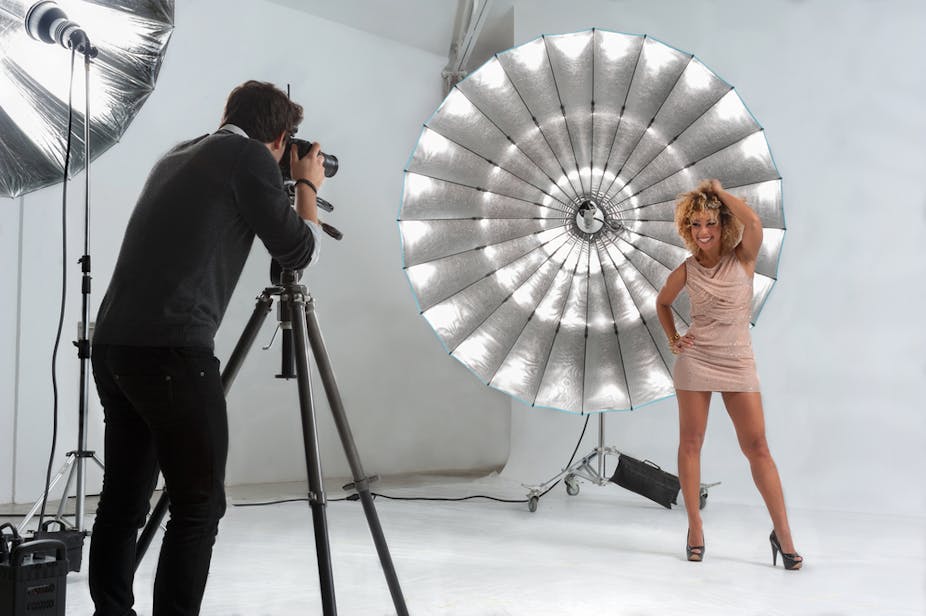How glamour photography makes suburban stars of us all
by P. David Marshall

Glamour photography sells both the experience and the product. WEExp/Shutterstock
In shopping centres and malls across much of Australia and North America, a peculiar and particular type of photography business makes itself at home. It goes under a number of names and guises, but is generally described as glamour photography. At the core of this particular business is creating images that make the everyday person feel extraordinary; a “star”. One of these businesses, Starshots, with its 16 franchised studios across Australia, is nicely nestled in the suburban landscape. It advertises itself in glossy posters in the malls themselves with provocative photos of subjects dressed in what could be described as naughty gear.
On its website, Starshots explains its basic philosophy. Through the “Starshots experience”, the client is to be pampered with a “proven formula” of make-up, hairstylists, props and the accessories of a true studio photo shoot in order to capture the “essence of you”. In other words, the experience is as important as the end product. Naturally, as would happen with a professional magazine covershoot, the added service of touch-up and digital altering images is there to capture the “real you”.
In shopping centres and malls across much of Australia and North America, a peculiar and particular type of photography business makes itself at home. It goes under a number of names and guises, but is generally described as glamour photography. At the core of this particular business is creating images that make the everyday person feel extraordinary; a “star”. One of these businesses, Starshots, with its 16 franchised studios across Australia, is nicely nestled in the suburban landscape. It advertises itself in glossy posters in the malls themselves with provocative photos of subjects dressed in what could be described as naughty gear.
On its website, Starshots explains its basic philosophy. Through the “Starshots experience”, the client is to be pampered with a “proven formula” of make-up, hairstylists, props and the accessories of a true studio photo shoot in order to capture the “essence of you”. In other words, the experience is as important as the end product. Naturally, as would happen with a professional magazine covershoot, the added service of touch-up and digital altering images is there to capture the “real you”.
From Hollywood to the mall
Glamour photography as an industry has an interesting lineage, which may help explain its current location in the suburban mall. Carol Dyhouse, the British historian and author of the book Glamour: Women, History, Feminism, says “glamour is a slithery concept”. It relies on its strong connection to the stars of classic Hollywood, where the notion of glamour and its associated fur, slinky dresses and attitude were an expression of the modern woman negotiating her public place in the contemporary world.

But it is also a soiled concept. Glamour photography, as the 20th century progressed, became associated with what was called boudoir photography, as even the idea of glamour began to be connected to tackiness.
The most public version of this kind of photography was the soft-core pornography promulgated by the mid to late 20th-century magazine icons, Playboy and Penthouse.
The particular photographic studios that now promote glamour photography in the shopping malls are trying to sanitise this bedroom photography and associate it more closely with the production of ourselves as stars so that couples, as much as women, can feel good about their sensual selves.
But why is it becoming both normal and popular now?
--Nicci Romanovsky

But it is also a soiled concept. Glamour photography, as the 20th century progressed, became associated with what was called boudoir photography, as even the idea of glamour began to be connected to tackiness.
The most public version of this kind of photography was the soft-core pornography promulgated by the mid to late 20th-century magazine icons, Playboy and Penthouse.
The particular photographic studios that now promote glamour photography in the shopping malls are trying to sanitise this bedroom photography and associate it more closely with the production of ourselves as stars so that couples, as much as women, can feel good about their sensual selves.
But why is it becoming both normal and popular now?
--Nicci Romanovsky
Industry upheaval
This particular version of glamour photography has been building for the last 15 years. Over the same period, the advent of digital photography has forced the photography industry through its greatest upheaval in years. American industry reports show that there has been a general decline in both revenues and number of commercial photo studios. The 2012 Barnes Reportrecorded a 10% shrinkage of the America
 n commercial photography industry.
n commercial photography industry.
At the same time, people are producing many more photos and distributing them at unprecedented rates, thanks to social media and our growing collections of digital devices. The 40 million images uploaded every day to the photo sharing site Instagram underscore the scale of the change. Professional photography has had to find a way to offer more. Glamour photography thus attempts to do what reality television actually does: it offers the service of “celebrifying” the individual. The photographs produced are very likely only to remain in one’s own household, but they echo the pantheon of star images that we see produced daily by sophisticated entertainment industries. Glamour photographic studios are generalising the “star experience” we witness in the endless talent shows and reality TV programs that turn everyday people into celebrities. Glamour shots allow one’s own body and self to be incorporated into the contemporary media system, even if it’s only to capture the “look” of fame for one’s own pleasure.
It’s easy to lampoon the glamour photo aesthetic. lintmachine

At the same time, people are producing many more photos and distributing them at unprecedented rates, thanks to social media and our growing collections of digital devices. The 40 million images uploaded every day to the photo sharing site Instagram underscore the scale of the change. Professional photography has had to find a way to offer more. Glamour photography thus attempts to do what reality television actually does: it offers the service of “celebrifying” the individual. The photographs produced are very likely only to remain in one’s own household, but they echo the pantheon of star images that we see produced daily by sophisticated entertainment industries. Glamour photographic studios are generalising the “star experience” we witness in the endless talent shows and reality TV programs that turn everyday people into celebrities. Glamour shots allow one’s own body and self to be incorporated into the contemporary media system, even if it’s only to capture the “look” of fame for one’s own pleasure.
It’s easy to lampoon the glamour photo aesthetic. lintmachine
Family glam
Starshots is not the only player in this world. Photography studios such as the franchisable Verve cater to the family portrait and are expert at making their portraits distinctive in their clear appeal to the aesthetic of magazine photography. Its portraiture is a combination of the works of Canadian-Turkish photographer Yousuf Karsh and US celebrity photographer Annie Liebovitz; it is magazine cover photography for the middle class.Verve’s slogan identifies this intermediary role:
The beautiful images captured from your photography session are handcrafted into creative, original works of art.
The experience of the studio draws you into a world of feeling significant.
So, as you are being jostled and bumped in your navigation through malls and shopping centres this Christmas shopping season, perhaps you may need to take a glamour photography moment and be pampered – if only temporarily – as a star.
-.-.-.-
Author: P. David Marshall, Professor and Personal Chair in New Media, Communication and Cultural Studies, Deakin University.
This article is republished from The Conversation under a Creative Commons license. Read the original article here.

